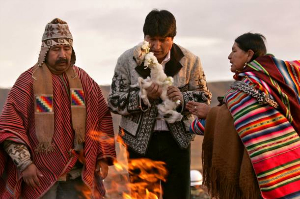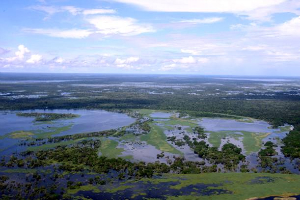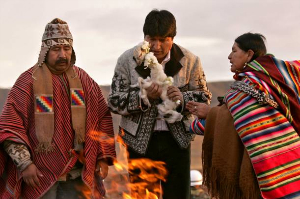President Evo Morales of Bolivia never shies away from a scuffle. He was elected as Bolivia’s first indigenous president after toppling the previous government with massive street protests, and he has since legalized the coca leaf, nationalized the mines, and tossed out the U.S. ambassador.
 Bolivian President Evo Morales makes an offering to the “Pachamama” (The Mother Earth) during a ritual at the sacred Aymara site of Tiwanaku, Bolivia. Morales has called for rich nations to take on the problem of global warming, noting that the worst effects fall on poor nations.Photo: Noah Friedman-RudovskyThe one-time coca farmer and llama herder is now wading into the ring of global climate negotiations to embark on his grandest crusade to date. His twenty-point list of demands on international climate policy represents the toughest line taken by any national leader, including a call for developed countries to contribute one percent of GDP — close to $700 billion per year — to a compensatory adaptation fund for poor and vulnerable nations.
Bolivian President Evo Morales makes an offering to the “Pachamama” (The Mother Earth) during a ritual at the sacred Aymara site of Tiwanaku, Bolivia. Morales has called for rich nations to take on the problem of global warming, noting that the worst effects fall on poor nations.Photo: Noah Friedman-RudovskyThe one-time coca farmer and llama herder is now wading into the ring of global climate negotiations to embark on his grandest crusade to date. His twenty-point list of demands on international climate policy represents the toughest line taken by any national leader, including a call for developed countries to contribute one percent of GDP — close to $700 billion per year — to a compensatory adaptation fund for poor and vulnerable nations.
“Western development has created a deathly wound to our Pachamama,” says Bolivian Foreign Minister David Choquehuanca, using the Aymara term for Mother Earth. “Industrialized countries need to assume their responsibilities.”
If the United States agreed to finance Bolivia’s proposal based on its 2008 GDP, it would owe roughly $146 billion — over 11,000 times more than America spent on international adaptation in the 2008 fiscal year.
It’s just the kind of uphill battle that the Bolivian government likes best.
“We think even this figure is small,” says Juan Pablo Ramos, Vice-Minister of the Environment, “when we consider the $700 billion bailout for the U.S. financial crisis.”
Bolivia’s case rests on an argument that is rapidly gaining ground in poor countries — that climate change must be addressed as a fundamental threat to development. Economic losses that can ultimately be traced back to industrialized nations’ carbon emissions, they maintain, must be compensated with the same urgency that these countries have discovered in confronting their own financial crises.
Instead of talking about the ecological footprint of Bolivian development, Ramos is concerned with “the ecological footprint on our development” — and worries that his country is getting squashed.
Gisela Ulloa, coordinator of Bolivia’s Clean Development Office, says that the nation has “lost a large percentage of GDP in the last couple of years from climatic events” that the Intergovernmental Panel on Climate Change has linked to global warming, including flooding disasters in its Amazonian lowlands and the melting of Andean glaciers critical to water supply. Adaptation funding, in Bolivia’s view, should address both the costs of these present-day damages and the opportunity costs of foregoing Western style industrialization.
This North-South perception gap about the nature of the threat posed by climate change is widely unrecognized by government and environmental leaders in developed nations.
“In the industrialized countries, climate change is seen as an environmental issue and not a development issue,” says Adil Najam, lead author of the sustainable development section of the 2007 IPCC assessment. “For most of the people of the world, it is and will remain a development challenge.”
The Bolivian government believes that it can shift the very framework of the global debate on climate change. The nation’s “fundamental strategy,” says Ramos, is to develop third-world block positions at Copenhagen and beyond to redefine the world’s approach to climate policy. At treaty negotiations this April in Bonn, Bolivia had gathered a trio of leftist Latin American allies to demand compensation for the “climate debt” — Venezuela, Nicaragua, and Honduras.
Global environmental institutions, he argues, should see their primary obligation as serving the world’s poorest nations, who contributed least to the problem and whose chances for development face profound environmental barriers.
The international approach that Bolivia envisions would start with a greater emphasis on adaptation, which they say is the primary challenge facing third-world states. It would reject market mechanisms, which Bolivia claims reward polluters rather than victims of climate change, in favor of aid to developing countries. Governments could access these funds through streamlined procedures instead of submitting formal proposals to the Global Environment Facility, a process that often takes years.
For their part, industrialized nations would cut carbon emissions by 40 percent by 2020 and 90 percent by 2050. They would eliminate all subsidies for fossil fuels, end patents on green technologies, and directly finance avoided deforestation in the poor world.
“Radical measures are needed to produce massive results,” says Vice-Minister Ramos.
Bolivia is facing long odds. The climate adaptation financing proposals Bolivia’s leaders want are not only exponentially greater than what Western governments are currently paying, they’re well beyond the range of what Western NGOs are recommending. Oxfam, for example, has issued an influential report calling for rich countries to spend $50 billion per year on adaptation – almost fourteen times less than the Bolivian proposal.
 Heavy rains caused major flooding in Bolivia in 2007 and 2008, where large portions of the country, like the Beni region, were under water for months. President Evo Morales has called on wealthy nations to shoulder the burden for global warming.Photo by Noah Friedman-RudovskyBolivia’s emphasis on the poorest nations, exemplified by its demand to restructure the Clean Development Mechanism to serve least developed states rather than industrializing giants, is also unlikely to be taken kindly by developing world heavyweights such as China, India and Brazil.
Heavy rains caused major flooding in Bolivia in 2007 and 2008, where large portions of the country, like the Beni region, were under water for months. President Evo Morales has called on wealthy nations to shoulder the burden for global warming.Photo by Noah Friedman-RudovskyBolivia’s emphasis on the poorest nations, exemplified by its demand to restructure the Clean Development Mechanism to serve least developed states rather than industrializing giants, is also unlikely to be taken kindly by developing world heavyweights such as China, India and Brazil.
All told, Adil Najam isn’t holding his breath for a third-world climate policy revolution.
“Part of me wishes that was going to happen, but it ain’t going to,” he says. “Wake me up when it does.”
Nevertheless, the gridlock on adaptation financing has recently given signs of easing. Industrialized nations have pledged to include adaptation assistance in the Copenhagen climate treaty, and U.S. climate envoy Todd Stern has called for “substantial funds” for adaptation in the developing world to be incorporated in a U.S. cap-and-trade bill. Two of the leading climate proposals in the last Congress, the Lieberman-Warner and Markey bills, called for roughly $1 billion and $2-2.5 billion per year, respectively, for adaptation assistance.
This range would represent an increase on the order of a hundredfold in U.S. support for adaptation — though still about ten times less than Oxfam recommends, and a hundred times less than Bolivia demands.
Adele Morris, an expert on climate change economics at the Brookings Institution, is concerned that a radical stand on financing on could endanger the prospects of a new treaty.
“The challenge will be getting a consensus in Copenhagen that’s also ratifiable in Congress,” she says. “You would hate to see the U.S.’ ability to reach agreement torpedoed by overly ambitious demands from Bolivia.”
An official in Bolivia’s National Climate Change Program indicates that the country is likely to sign any agreement that emerges from Copenhagen. But the government insists that the current debate on adaptation funding amounts to shifting deck chairs on the Titanic. At the Poznan negotiations last December, delegates from rich and poor nations stalked out unable to reach agreement over a single percentage point in the rate of proceeds from global carbon markets that would be dedicated to adaptation.
“We were fighting for around $80 million for so many countries, but that’s not going to save Tuvalu,” says Gisela Ulloa, who represented Bolivia as a delegate. “It was a disaster. It was almost a waste of time.”
Bolivia is convinced that this can only be resolved when developed nations fundamentally change their understanding of the role of adaptation. And until this occurs, Bolivian officials promise that we’ll be hearing a whole lot more from them.
Bolivian officials says they will form a coalition of underdogs, including indigenous groups, social movements, and the world’s most vulnerable states, into a pack so large that their case can no longer be denied.
“We are going to make our point more forcefully in the coming months,” says Juan Pablo Ramos. “So that it is not an isolated voice, but a global demand of various nations and various peoples that eventually becomes a requirement.”



